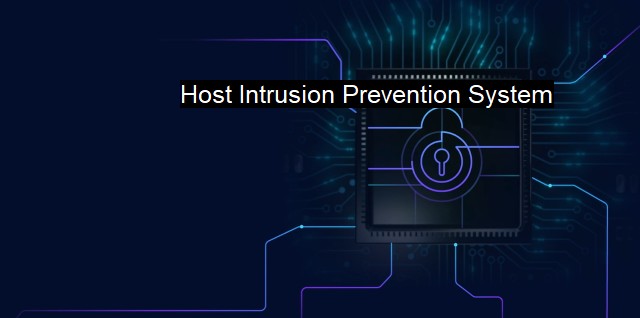What is Host Intrusion Prevention System?
Defend Your Endpoints with Host Intrusion Prevention System - Advanced Threat Protection Against Cyber Attacks
The Host Intrusion Prevention System (HIPS) is a vital tool used in the realm of cybersecurity for ensuring an additional layer of protection to the networks. It is a security software that takes a proactive stance towards any potential, threatening or malicious activity attempting to intrude or compromise a system's security. Complementary to an antivirus software that defends the systems from known threats, and the firewall that blocks unauthorized access, a HIPS goes a step ahead in taking corrective actions when there is abnormal behavior exhibited in a system, or when new unidentified threats emerge.In contrast to the network-based intrusion detection and prevention systems that guard against unauthorized system-level intrusions, a HIPS is system-based and acts as a bodyguard to individual servers or terminal devices within the system. This intricate difference enables HIPS to focus on internal system process activities, which makes it possible for it to monitor every system's file and operation, with every individual piece of data, in real time.
HIPS primarily functions through certain established techniques. The first formative methodology flows through signature-based detection that involves analysis and comparison of behavioral patterns from malicious programs with signature databases. As soon as a pattern aligns with the database, the HIPS spring into action. this mechanism can only tackle recognized threats.
Second, a more advanced technique of the HIPS is the use of heuristics, or rules devised to detect malicious activities. The HIPS is triggered to action when these predetermined rules are violated. While it has been effective against the majority of the unidentified or variant threats it does reflect a risk of generating false positives.
The third method initiated by HIPS alludes to sandboxing wherein isolating a system’s function, or application in a controlled setting helps evaluate the behavior without risking the entire network. This process is quantifiable in terms of time but has proven successful against zero-day threats.
The contemporary technique employed by HIPS is machine learning or artificial intelligence. Adapted to continually learn and enhance its detection and response capabilities to threats, AI or ML-powered HIPS can outmaneuver traditional non-learning HIPS in the long run even if the false-positives rate tends to be a little unforgiving initially.
Like with most systems, HIPS comes with its advantages and disadvantages. Among the benefits, foremost is the real-time protection it offers to systems as it’s observed and alerted in real time avoiding potential damages. Further, the security protection layer it extends internally without relying matches a line-up defense strategy proving advantageous over traditional security software that only respond upon problem detection.
It suffers certain restraints such as higher false positives inciting instances of nuisances and distractions for users or potentially blocking essential operations. setting up the HIPS can be complex needing continual tuning and updates, and its possibly higher consumption of system resources could limit system performance.
Despite these challenges, HIPS holds a prominent place in cybersecurity due its predictive and adaptive safeguarding approach adding multi-fold strength to the protection of systems and the networks they operate within. Alongside deploying antivirus programs and firewalls, Integrating HIPS into cyber strategies is therefore paramount for an optimal and robust cybersecurity standing, especially in a world where cyber threats are continuously evolving to breach the security wall at various levels – be it the network, systems, devices or endpoint.

Host Intrusion Prevention System FAQs
What is a host intrusion prevention system (HIPS)?
A host intrusion prevention system (HIPS) is a type of security software that runs on endpoints (such as servers, desktops, and mobile devices) to prevent against malicious activity by monitoring and analyzing network traffic and system behavior. HIPS can also block or prevent unauthorized access, malware infections, and other security threats.How does a host intrusion prevention system differ from antivirus software?
While antivirus software focuses on detecting and removing malware infections, a host intrusion prevention system (HIPS) monitors all system activity to detect and prevent malicious behavior, including malware infections, unauthorized access attempts, and other security threats. HIPS can also provide more granular control over system activity and network traffic.Can a host intrusion prevention system be deployed in a cloud environment?
Yes, a host intrusion prevention system (HIPS) can be deployed in a cloud environment to protect cloud-based applications and workloads. Cloud-compatible HIPS solutions can be integrated directly into cloud platforms, such as Amazon Web Services (AWS) and Microsoft Azure, and can provide real-time threat detection and response in a cloud environment.What are some key features of a host intrusion prevention system?
Some key features of a host intrusion prevention system (HIPS) may include: 1. Real-time threat detection and response 2. Behavioral analysis to detect and prevent zero-day attacks 3. Application control to prevent unauthorized access and protect against application-based attacks 4. Network traffic monitoring and analysis 5. Granular policy enforcement and rule customization 6. Integration with other security tools and platforms| | A | | | B | | | C | | | D | | | E | | | F | | | G | | | H | | | I | | | J | | | K | | | L | | | M | |
| | N | | | O | | | P | | | Q | | | R | | | S | | | T | | | U | | | V | | | W | | | X | | | Y | | | Z | |
| | 1 | | | 2 | | | 3 | | | 4 | | | 7 | | | 8 | | |||||||